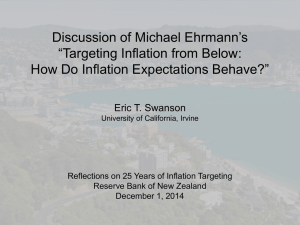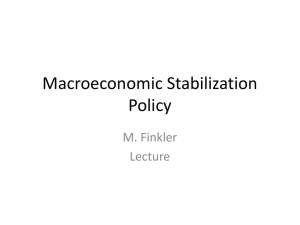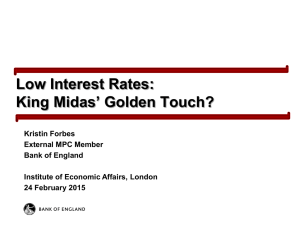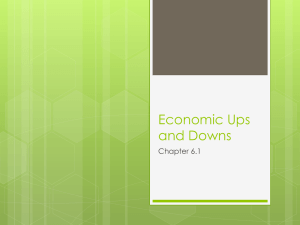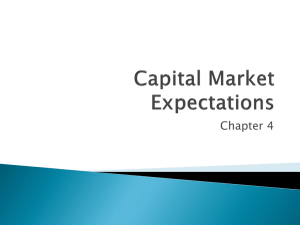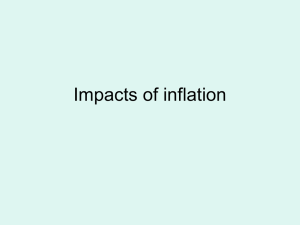Inflation Targeting
advertisement
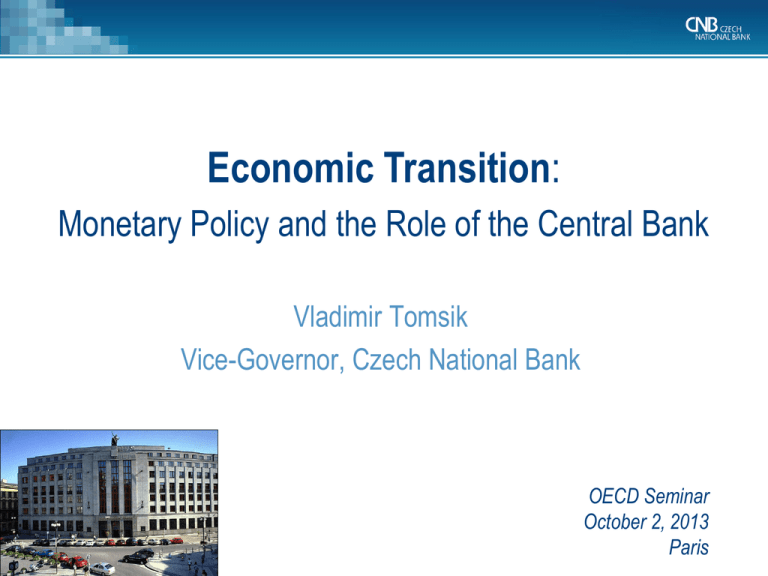
Economic Transition: Monetary Policy and the Role of the Central Bank Vladimir Tomsik Vice-Governor, Czech National Bank OECD Seminar October 2, 2013 Paris Outline • Starting Point – Macroeconomic Background and Policy Challenges • First Steps in the Transition Period + Split of Czechoslovakia • Currency Crisis in 1997 • Inflation Targeting and its Development • Current Challenge: Zero Lower Bound 2 Starting Point – Background, Main Challenges • No financial institutions and markets • Non-convertible currency, system of many different exchange rates • Foreign trade and GDP plunged following the collapse of the eastern markets, companies had problems selling their products and repaying their loans Main economic policy challenges • Need to create financial institutions and markets • Liberalization of prices (+ tax reform in 1993) • Privatization of the state property • Building an adequate institutional and legal framework • Economic reforms towards market economy • Reorientation of the trade towards Western countries • Choice of the exchange rate and monetary policy regime 3 Main Challenges for the Central Bank • Creation of two-tier banking system: separation of commercial bank and central bank functions • High inflation as a result of price liberalization and multiple devaluations • But the push for disinflation had to be balanced with the need to reverse the economic contraction, kick-start economic growth and improve living standards • 1993: split of Czechoslovakia and the federal CB, currency separation 4 Monetary Policy: First Steps in the Transition Period • 1990: four devaluations of the Czech koruna • Two pillars: fixed exchange rate + money growth target • Owing to immature financial market, direct (administrative) instruments had to be used – credit limits and interest rate caps – required reserves – short term refinancial credit • ...only gradually indirect instruments started to be used • Internal and external currency convertibility gradually introduced, liberalisation of cross-border financial flows (1995 OECD entry provided a strong incentive to proceed fast) 5 Economic Performance, Problems Arising... Annual inflation (%) 60 price of 95% of items liberalized + effect of devaluations 50 40 VAT introduced 30 20 10 • Inflation peaked in 1991 after liberalisation of prices and fluctuated around 10%, except in 1993 when the introduction of VAT created a one-off inflationary impulse • Inflation was much lower than in Poland (hyperinflation in 1990) and in Hungary 0 1990 1991 1992 1993 1994 1995 1996 10 Real GDP growth (%) 5 0 -5 -10 -15 1990 1991 1992 1993 1994 1995 1996 • GDP growth picked up, but... • high wage growth not covered by productivity gains • fast domestic demand growth • sharp deterioration of the CA deficit • classified loans piling up • supply side constraints • procyclical fiscal policy in booming years 6 Impossible Trinity free capital flows ER peg autonomy of MP • Capital account liberalisation (1995) + ER peg + positive interest rate differential → large foreign capital inflows • CB absorbed excess supply of foreign exchange → additional liquidity – vs. the money supply growth target • Withdrawal of this excess liquidity led to growth in interest rates which stimulated the capital inflow even more CB interventions liberalised capital flows interest rate differential fixed exchange rate macroeconomic and political stability capital inflow sterilization trap interest rate acceleration M2 growth sterilisation 7 Currency Turmoil in 1997 • Fluctuation band widened to ±7.5% (February 1996) • External imbalance still worsening • Rising problems in the banking sector • Tension on the political scene • Eroding confidence of foreign investors • Contagion effect of the Asian crisis May 1997 • Massive outflow of short-term capital and speculative attack on the koruna • CNB defended the currency by sharply raising interest rates and intervening on a massive scale • In the end the fixed exchange rate had to be abandoned 75 CB interest rates (%) 60 1w repo 45 2w repo 30 15 Lombard rate Discount rate 0 1990 1991 1992 1993 1994 1995 1996 1997 1998 1999 120 110 Exchange rate index (%) 0.5% fluctuation band 27.9.1992 – 27.2.1996 100 90 80 7.5% fluctuation band 28.2.1996 – 27.5.1997 70 depreciation 60 appreciation 50 1990 1991 1992 1993 1994 1995 1996 1997 1998 1999 8 After the Crisis... • After the peg was abolished, koruna depreciated → higher inflation and inflation expectations → monetary policy tightening → higher interest rates worsened availability of credit → slowdown in economic growth + worsening repayment of credit • Consequences were not dramatic in comparison to other countries with similar shocks – exchange rate hovered only approx. 10% below the former central parity, its impact on inflation was less than 2pp • M2 became the only intermediate target but • not understandable for public – need to anchor inflation expectations • implementation problems • Decision to adopt inflation targeting π 9 Inflation Targeting • Evolution of the target • Escape clauses • Forecasting system constantly improved and refined • Conditional forecast → unconditional forecasts • From 2002 QPM, from 2008 g3 (small open economy DSGE model) • Increasing transparency: • Press conference after monetary policy decisions • Inflation report, Minutes, Votes of bank board members • Publication of interest rate and exchange rate forecasts 10 Inflation Targeting – Inflation Targets 22 20 Inflation targeting 18 16 14 12 Targets for net inflation 10 Targets for CPI 8 6 4 2 0 -2 1993 94 95 96 97 98 99 2000 01 02 03 04 05 06 07 08 09 2010 11 12 13 • First targets set in terms of net inflation (netted of regulated prices and indirect taxes) → Targets for CPI • Band → Point target 11 Inflation Targeting – Inflation 22 20 Inflation targeting 18 16 14 12 Targets for net inflation 10 Targets for CPI 8 CPI 6 4 Net inflation 2 0 -2 1993 94 95 96 97 98 99 2000 01 02 03 04 05 06 07 08 09 2010 11 • Inflation gradually fell down • Low and stable inflation, inflation expectations well anchored • Undershooting of the target more frequent then overshhoting 12 13 12 Inflation Targeting – Main Policy Rates 20 Inflation targeting 18 16 14 12 10 Lombard rate 8 2w repo 6 Discount rate 4 2 0 1993 94 95 96 97 98 99 2000 01 02 03 04 05 06 07 08 09 2010 11 12 13 • Interest rates down to low levels • Currently 2w repo rate at "technical" zero 13 Inflation Targeting – Economic Activity 8 Inflation targeting 7 CZ 6 5 4 3 2 EA (changing composition) 1 0 -1 -2 -3 -4 -5 1993 94 95 96 97 98 99 2000 01 02 03 04 05 06 07 08 09 2010 11 12 • Economy hit by the world economic crisis – impact on exports and GDP • Domestic fiscal policy tightening, pessimistic sentiment • No financial crisis – sound financial institutions 14 Inflation Targeting – Exchange Rate 40 16 12 38 8 36 4 0 34 -4 -8 32 -12 30 -16 -20 28 -24 26 -28 -32 -36 Inflation targeting depreciation appreciation 24 -40 22 1993 94 95 96 97 98 99 2000 01 02 03 04 05 06 07 08 09 2010 11 12 13 • Long-run nominal appreciation trend before crisis, low inflation • Flexible ER = adjustment mechanism (e.g. In 2008-2009 and now) • Flexible ER + low IRs → no FX loans – financial stability preserved 15 Zero Lower Bound – What Next? • Repo rate cut to 0.05% in November 2012 • Inflation below the target, anti-inflationary domestic pressures, further monetary policy easing needed • Exchange rate interventions considered • Exchange rate channel to elevate inflation (expectation channel) • Liquidity surplus in the Czech banking system → no need for liquidity injections • IR transmission functional • Verbal interventions 26.2 CZK/EUR 25.8 25.4 depreciation 25.0 appreciation 24.6 10 11 2012 12 01 02 03 04 05 06 07 08 09 2013 • Income on international reserves not being sold since November • Forward guidance: rates will be kept at zero level in the longer term until inflation pressures rise significantly 16 Current Forecast 6 Inflation (%) 5 6 Monetary policy horizon 5 4 4 3 3 2 Inflation target MP inflation (%) Inflation target 2 1 1 0 0 Monetary policy horizon -1 -1 III/11 IV I/12 II III IV I/13 II III IV I/14 II III 3M PRIBOR (%) 4 III/11 IV I/12 II IV I/15 III IV I/13 II III IV I/14 II III IV I/15 III IV I/15 GDP growth (%) 10 8 3 6 4 2 2 0 1 -2 -4 0 III/11 IV I/12 II III IV I/13 II III IV I/14 II III IV I/15 III/11 IV I/12 II III IV I/13 II III IV I/14 II 17 Lessons to Be Learnt • Impossible trinity is really impossible • On the contrary, internally and mutually consistent economic policies of all national authorities must be in place • Credibility is of utmost importance (together with accountability and transparency) • Inflation targeting proved to be successful monetary policy regime, also when used as disinflation strategy • Macro stability supports (although does not guarantee) financial stability • Flexible exchange rate has been a useful adjustment mechanism during the crisis (and now at the ZLB also possibly a monetary policy tool) • Thus: own currency, independent MP and flexible exchange rate are an asset of a considerable value 18 To conclude... During two decades... • Successful currency separation in 1993 • Inflation targeting • Not rigid, evolved during time • Proved to be convenient monetary policy regime – successful disinflation, inflation expectations well anchored • Current challenge: Zero lower bound • CNB one of the most open and transparent central banks • And one of the most trusted institutions in the Czech Republic 19 Back-up slides 20 First decade in pictures Annual inflation (%) 60 price of 95% of items liberalized + effect of devaluations 50 CB interest rates (%) 75 60 40 VAT introduced 1w repo 45 30 2w repo 30 20 15 10 Discount rate 0 0 1990 1991 1992 1993 1994 1995 1996 1997 1998 1999 10 Lombard rate Real GDP growth (%) 1990 1991 1992 1993 1994 1995 1996 1997 1998 1999 120 110 5 Exchange rate index (%) 0.5% fluctuation band 27.9.1992 – 27.2.1996 100 0 90 80 -5 7.5% fluctuation band 28.2.1996 – 27.5.1997 70 -10 depreciation 60 appreciation 50 -15 1990 1991 1992 1993 1994 1995 1996 1997 1998 1999 1990 1991 1992 1993 1994 1995 1996 1997 1998 1999 21 Fifteen Years of Inflation Targeting Inflation (%) 14 18 12 16 10 14 12 Targets for net inflation 8 CB interest rates (%) 20 10 Targets for CPI 6 Lombard rate 8 CPI 4 2w repo 6 4 2 Net inflation 0 98 99 2000 01 2 02 03 04 05 06 07 08 09 2010 11 12 13 Discount rate 0 98 99 2000 01 02 03 04 05 06 07 08 09 2010 11 12 13 12 13 -2 Real GDP growth (%) Exchange rate (CZK/EUR) 40 7 6 5 4 3 2 1 0 -1 -2 -3 -4 -5 38 36 34 32 30 28 26 depreciation 24 appreciation 22 98 99 2000 01 02 03 04 05 06 07 08 09 2010 11 12 98 99 2000 01 02 03 04 05 06 07 08 09 2010 11 22 Current Forecast – Exchange Rate (CZK/EUR) 29 27 25 23 21 III/11 IV I/12 II 90% III IV 70% I/13 II III IV I/14 50% 30% confidence interval II III IV I/15 23


